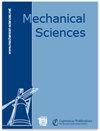类海狸水下机器人后腿游泳动力学建模与实验
IF 1.5
4区 工程技术
Q4 ENGINEERING, MECHANICAL
引用次数: 0
摘要
摘要当类似海狸的水下机器人游泳时,它的后腿为身体提供主要的推动力,这是机器人运动的动力来源。后肢游泳动力学是分析机器人游泳过程中推进力产生和变化的基础,它直接决定了机器人游泳轨迹的规划。然而,关于类海狸水下机器人后肢的游泳动力学研究却很少。本文提出了一种刚性-液体融合动力学建模方法,将类海狸机器人后腿的游泳动力学简化为蹼足的流体动力学和大腿和小腿的刚体动力学。基于积分流体力学方法建立了可弯曲腹板足的流体力学模型,并采用牛顿-欧拉方法建立了大腿和小腿的刚体动力学模型。通过力的传递,建立了后肢的整体游泳动力学模型,得到了后肢对身体的推进力和升力。ANSYS Fluent对机器人单腿和水下单腿游泳实验的运动进行了仿真,验证了动力学模型的正确性和有效性。通过比较仿生游泳、增幅游泳和减幅游泳条件下机器人后腿的推进力和升力的理论、仿真和实验结果,进一步验证了所提出的刚性-液体融合动力学建模方法的正确性,证明了机器人仿生游动轨迹的优越性。本研究可为可弯曲蹼足水下游泳机器人的腿部动力学建模提供新的思路,为探索水下机器人的游泳力学过程奠定理论基础。本文章由计算机程序翻译,如有差异,请以英文原文为准。
Dynamic modeling and experiment of hind leg swimming of beaver-like underwater robot
Abstract. When the beaver-like underwater robot is swimming, its hind legs provide the
main propulsion force for the body, which is the source of power for the
robot's movement. Hind leg swimming dynamics is the basis for analyzing the
generation and change of propulsion force during the robot swimming process,
which directly determines how the robot swimming trajectory is planned.
However, there are few researches on the swimming dynamics of the hind leg
of a beaver-like underwater robot. This paper proposes a rigid–liquid fusion
dynamics modeling method, which simplifies the swimming dynamics of hind
legs of beaver-like robot to hydrodynamics of webbed feet and rigid body
dynamics of thighs and calves. The hydrodynamics of the bendable webbed foot is
established based on the integral hydrodynamics method, and the rigid body
dynamic model of the thigh and calf is constructed using the Newton–Euler
method. Through the force transmission, the overall swimming dynamic model
of the hind leg is established, and the propulsion and lift force of the hind leg
to body are obtained. The ANSYS Fluent simulation of the movement of robot's
hind leg and underwater single-leg swimming experiments verify the
correctness and effectiveness of the dynamics model. Comparing the theory,
simulation, and experimental results of the propulsion and lift force of the
robot's hind legs under bionic swimming, increased amplitude swimming, and
reduced amplitude swimming, it further verifies the correctness of the
proposed rigid–liquid fusion dynamic modeling method, and proves the
superiority of the robot's bionic swimming trajectory. This study can
provide new ideas for the leg dynamic modeling of underwater swimming robots
with bendable webbed feet, and lay a theoretical foundation for exploring
the swimming mechanical process of underwater robots.
求助全文
通过发布文献求助,成功后即可免费获取论文全文。
去求助
来源期刊

Mechanical Sciences
ENGINEERING, MECHANICAL-
CiteScore
2.20
自引率
7.10%
发文量
74
审稿时长
29 weeks
期刊介绍:
The journal Mechanical Sciences (MS) is an international forum for the dissemination of original contributions in the field of theoretical and applied mechanics. Its main ambition is to provide a platform for young researchers to build up a portfolio of high-quality peer-reviewed journal articles. To this end we employ an open-access publication model with moderate page charges, aiming for fast publication and great citation opportunities. A large board of reputable editors makes this possible. The journal will also publish special issues dealing with the current state of the art and future research directions in mechanical sciences. While in-depth research articles are preferred, review articles and short communications will also be considered. We intend and believe to provide a means of publication which complements established journals in the field.
 求助内容:
求助内容: 应助结果提醒方式:
应助结果提醒方式:


